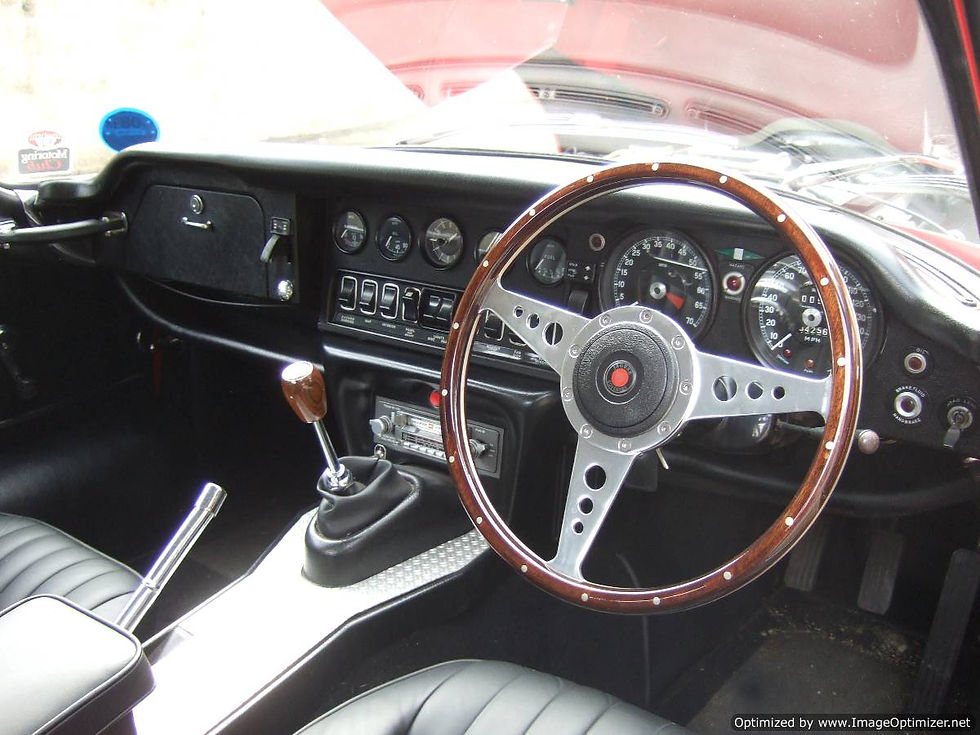
Jaguar E Type V12 Series III 1971
At around 7pm on Tuesday 14 March 1961, Jaguar’s PR department employee, Bob Berry, left Browns Lane, Coventry in a fixed head E-type, registered 9600 HP. Berry drove virtually flat out through the night, arriving in Geneva, where he drove to the local Jaguar distributor for a 20-minute wash and polish, before heading to the Parc des Eaux Vives for the public unveiling by Sir William Lyons. Surrounded by up to 200 members of the press, 9600 HP caused a sensation, and so did the price! At £2097 for the Roadster and £2196 for the FHC, it was considerably cheaper than similar performing cars from Ferrari, Aston Martin and Chevrolet, and was on a par with much slower cars from Porsche and AC. Incredibly, the E-type was initially sold at a cheaper price than the outgoing XK150.
Date of Manufacture: 21st October 1971.
A new 5.3 L twelve-cylinder Jaguar V12 engine was introduced, with uprated brakes and standard power steering. The short wheelbase FHC body style was discontinued and the V12 was available only as a convertible and 2+2 coupé. The convertible used the longer-wheelbase 2+2 floorplan. The Series 3 is easily identifiable by the large cross-slatted front grille and flared wheel arches, and a badge on the rear that proclaims it to be a V12. Cars for the US market were fitted with large projecting rubber bumper over-riders - in 1973 these were only on the front - and in 1974 on both front and rear to meet local 5 mph (8 km/h) impact regulations; those on European models were considerably smaller. US models also have side indicator repeaters on the front wings.
There were also a very limited number of six-cylinder Series 3 E-Types built, and these were featured in the initial sales literature.
When leaving the factory, both the V12 open convertible and 2+2 coupé were fitted with Dunlop E70VR/15 tyres on 15×6k wire or solid wheels.
Engine
V12, dohc
Bore & Stroke: 87mm x 106mm
Displacement: 3,781cc
Compression ratio: 9 to 1
Carburettors: 4
Power output: 265bhp at 6,000rpm
Transmission
RWD, 4-speed manual, synchromesh on top 3 ratios,
Borg-Warner automatic option
Performance
Maximum speed: 143mph
Acceleration: 0-60mph 6.8secs
Av. Fuel Consumption: 15.2mpg
Wheels
Knock-on 15in wire wheels with Dunlop R15 93h tyres
Dimensions & Weight
Wheelbase: 8ft 9in
Track – Front: 4ft 6.4in
Track – rear: 4ft 5.4in
Overall length: 15ft 5.6in
Overall width: 5ft 6.1in
Overall height: 4ft 0.1in
Ground clearance: 5.5in
Kerb weight: 30cwt
Chassis
Steel moncoque with square tube sub frame at front,
Press steel sub frame at rear
Steering
Rack and pinion
Suspension
Front: Independent with torsion bars, wishbones, anti roll bar
Rear: Independent, double spring/shock units, transverse lower links,
Longitudinal radius arms
Production
Convertible: 7,990 2+2 Coupes: 7,297
Total all Series III: 15,287

![FBHVC_master_logo[1].png](https://static.wixstatic.com/media/d58553_99b4113caa1b4fb5bd7da88d34c624d5~mv2.png/v1/fill/w_127,h_83,al_c,q_85,enc_avif,quality_auto/FBHVC_master_logo%5B1%5D.png)


